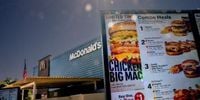McDonald’s, the world’s largest fast-food chain, is making a dramatic shift in its pricing strategy after months of mounting criticism over the soaring cost of its meals. On August 20, 2025, the company admitted that its combo meal prices had become too expensive for many customers, with some Big Mac meals reportedly reaching as high as $18 in certain locations, according to CNN and The Wall Street Journal. The move comes after weeks of internal debate and negotiations with franchise owners, as the chain seeks to recapture its reputation for affordability and win back value-minded diners who have been driven away by sticker shock.
Starting in September 2025, McDonald’s will slash the prices of its eight most popular combo meals. The new pricing structure will ensure that these meal deals are at least 15% less than the cost of purchasing the items individually, a change that the company hopes will make its menu more attractive to cost-conscious consumers. As part of the effort, McDonald’s is also rolling out a $5 breakfast deal and an $8 Big Mac and McNuggets special, marketing these as Extra Value Meals. These offerings are designed to directly counter the perception that fast food has become a luxury rather than a budget-friendly option.
“Our menu has gotten too expensive,” a McDonald’s spokesperson acknowledged in a statement quoted by CNN. The company’s leadership made no secret of the fact that high prices had become a barrier for many of its core customers. The announcement follows a period of intense scrutiny, as social media buzzed with complaints about the cost of a simple fast-food meal, and news outlets highlighted how some sit-down restaurants such as Chili’s and Applebee’s were now able to compete on price with the iconic burger chain. According to CNN, these casual dining competitors have been thriving in recent years, in part by offering full-service meals at price points that rival or undercut McDonald’s combos.
The decision to lower prices was not made lightly. According to The Wall Street Journal, the company spent weeks in discussions with its U.S. franchisees, some of whom were wary about cutting into already tight profit margins. McDonald’s reportedly offered financial support to franchise operators willing to participate in the price reduction plan, underscoring the urgency with which the company views the issue. In the end, both the corporate office and franchisees agreed to implement the new pricing, recognizing the need to act before even more customers defected to competitors.
The new pricing policy will affect eight of the chain’s most popular combo meals, though McDonald’s has not released the full list of which items will be included. What is clear is that the company is betting big on the appeal of its new Extra Value Meals. The $5 breakfast deal and the $8 Big Mac and McNugget combo are expected to be heavily advertised, with McDonald’s hoping to remind customers of its long-standing reputation for offering a quick, filling meal at a reasonable price.
Restoring that reputation is no small feat. In recent years, many consumers have complained that the McDonald’s experience no longer feels like a bargain. The introduction of the McValue deal menu was a step in the right direction, but according to company materials viewed by The Wall Street Journal, “many consumers still feel the chain’s menu prices overall are too high.” That perception has been reinforced by viral posts showing receipts for $15 or $18 Big Mac meals, a far cry from the brand’s original promise of affordable eats for everyone.
McDonald’s executives are acutely aware of the risks. As the cost of ingredients, labor, and rent has climbed, so too have menu prices across the fast-food industry. But the company’s leadership believes that failing to address consumer concerns would do even greater damage in the long run. “The move is part of the chain’s push to restore its reputation for affordability, which has taken a hit with cash-strapped consumers,” The Wall Street Journal reported. The company is also keenly aware that competition is heating up, not just from traditional fast-food rivals like Burger King and Wendy’s, but from sit-down chains that have managed to keep their prices in check while offering a different dining experience.
Industry analysts note that McDonald’s is facing a delicate balancing act. On one hand, the company must remain profitable and keep its franchisees happy. On the other, it cannot afford to alienate the millions of customers who made it a household name in the first place. The new pricing strategy is a calculated gamble, one that seeks to thread the needle between these competing priorities. If successful, it could set a precedent for other fast-food giants grappling with similar challenges.
The timing of the announcement is also significant. With inflation still a concern for many American families, and consumer spending showing signs of strain, the battle for the value-conscious diner has never been more intense. McDonald’s is betting that its revamped combo meals will lure back those who have drifted away, whether to rival chains or to the growing number of sit-down restaurants offering lunch and dinner specials at similar price points.
Of course, not everyone is convinced the changes will be enough. Some critics argue that a 15% discount on already high prices may not be sufficient to change consumer perceptions, especially if the underlying costs of individual menu items remain elevated. Others point out that the fast-food industry as a whole faces structural challenges, from rising wages to fluctuating supply costs, that make sustained low prices difficult to maintain.
Still, McDonald’s is moving forward with a sense of urgency. The company has promised that the new prices will take effect nationwide starting in September 2025, with the hope that the combination of lower prices and expanded value offerings will be enough to turn the tide. Only time will tell whether the strategy pays off, but one thing is clear: the fast-food landscape is changing, and McDonald’s is determined not to be left behind.
With its new pricing initiative, McDonald’s is making a bold play to reclaim its place at the top of the value menu. Whether customers respond as hoped remains to be seen, but the company’s willingness to acknowledge its missteps and take corrective action is a reminder that even the biggest brands must listen to their customers—or risk losing them for good.





